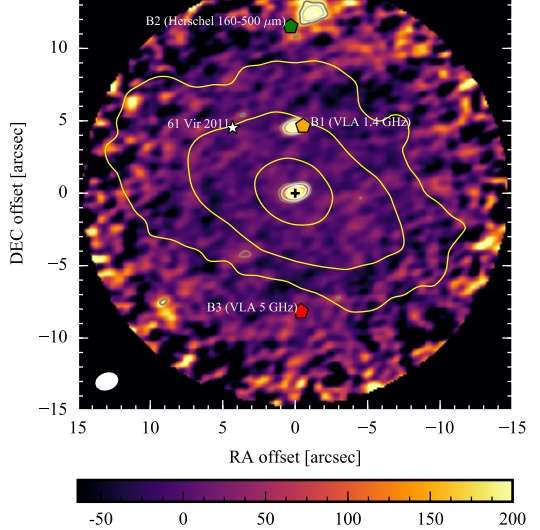May 11, 2017 report
Scientists investigate debris disk in a nearby planetary system

(Phys.org)—Astronomers have recently presented new results of observations of a nearby planetary system known as 61 Virginis (or 61 Vir for short). The observations were focused on investigating the system's debris disk, which could hold many clues to the nature of planetary formation beyond our solar system. The study is available in a paper published May 4 on the arXiv pre-print repository.
61 Vir is a G-type, 4.6-billion-year-old main-sequence star about the size of our sun, located approximately 28 light years away. The star is known to be orbited by at least three planets that are five, 18 and 23 times more massive than Earth. One of the most intriguing features of this system is a debris disk extending from 30 to at least 100 AU from the star.
Debris disks are clouds of planetesimals and dust found in orbits around many stars. Studying such disks could improve our understanding about planet formation and the migration history of planets in planetary systems. With this aim in mind, a team of astronomers led by Sebastian Marino of the University of Cambridge in the U.K., has performed observations of 61 Vir's debris disk using the Atacama Large Millimeter/submillimeter Array (ALMA) in Chile. These observations were complemented by data from the Submillimetre Common-User Bolometer Array 2 (SCUBA2) installed in the James Clerk Maxwell Telescope (JCMT) at Mauna Kea Observatory in Hawaii.
"In this paper, we present the first observations of 61 Vir with ALMA at 0.86 mm, obtained with the aim of studying its debris disc to reveal the location of the parent planetesimals, and place constraints on the presence of planets at large separations that can shape the mass distribution in the disc. (…) In order to obtain the best disc constraints, in our analysis we combine new ALMA band 7 observations and new data at 0.85 mm from SCUBA2 installed on JCMT, thus, incorporating information from small and large angular scale structure," the researchers wrote in the paper.
The new study reveals that the debris disk is larger than previously thought. Marino's team found that it extends from 30 to at least 150 AU. Combined ALMA and SCUBA2/JMCT observations also show that at 0.86 mm the total disc emission is about 3.7 mJy and the disk has a surface density distribution of millimeter sized grains with a power law slope of approximately 0.1.
Moreover, the researchers assume that a yet unseen fourth planet may lurk somewhere in the system between 61 Vir d at 0.5 AU and the inner edge of the disc. They argue that if the disc was stirred at 150 AU by an additional planet, that unseen alien world should have a mass of at least 10 Earth masses and should orbit its host at a distance between 10 and 20 AU.
"We found that in order to have stirred the disc out to 150 AU, the planet must be more massive than 10 Earth masses and a semi-major axis between 10 and 20 AU if it has an eccentricity lower than 0.1. Otherwise, for higher eccentricities, it could have a lower mass and a semi-major axis between 4 and 20 AU," the team concluded.
More information: ALMA observations of the multiplanet system 61 Vir: What lies outside super-Earth systems? arXiv:1705.01944 [astro-ph.EP] arxiv.org/abs/1705.01944
Abstract
A decade of surveys has hinted at a possible higher occurrence rate of debris discs in systems hosting low mass planets. This could be due to common favourable forming conditions for rocky planets close in and planetesimals at large radii. In this paper we present the first resolved millimetre study of the debris disc in the 4.6 Gyr old multiplanet system 61 Vir, combining ALMA and JCMT data at 0.86 mm. We fit the data using a parametric disc model, finding that the disc of planetesimals extends from 30 AU to at least 150 AU, with a surface density distribution of millimetre sized grains with a power law slope of 0.1+1.1−0.8. We also present a numerical collisional model that can predict the evolution of the surface density of millimetre grains for a given primordial disc, finding that it does not necessarily have the same radial profile as the total mass surface density (as previous studies suggested for the optical depth), with the former being flatter. Finally, we find that if the planetesimal disc was stirred at 150 AU by an additional unseen planet, that planet should be more massive than 10 M⊕ and lie between 10-20 AU. Lower planet masses and semi-major axes down to 4 AU are possible for eccentricities ≫ 0.1.
© 2017 Phys.org





















